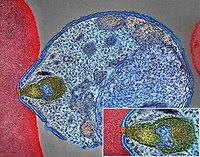
Photo from wikipedia
A two‐component reaction‐diffusion system to describe the spread of malaria is considered. The model describes the dynamics of the infected mosquitoes and of the infected humans. The spread of the… Click to show full abstract
A two‐component reaction‐diffusion system to describe the spread of malaria is considered. The model describes the dynamics of the infected mosquitoes and of the infected humans. The spread of the disease is controlled by three actions (controls) implemented in a subdomain of the habitat: killing mosquitoes, treating the infected humans, and reducing the contact rate mosquitoes‐humans. To start with, the problem of the eradicability of the disease is considered, while the cost of the controls is ignored. We prove that it is possible to decrease exponentially both the human and the vector infective population everywhere in the relevant habitat by acting only in a suitable subdomain. Later, the regional control problem of reducing the total cost of the damages produced by the disease, of the controls, and of the intervention in a certain subdomain is treated for the finite time horizon case. An iterative algorithm to decrease the total cost is proposed; apart from the three controls considered above, the logistic structure of the habitat is taken into account. The level set method is used as a key ingredient for describing the subregion of intervention. Some numerical simulations are given to illustrate the applicability of the theoretical results.
Journal Title: Mathematical Methods in the Applied Sciences
Year Published: 2019
Link to full text (if available)
Share on Social Media: Sign Up to like & get
recommendations!